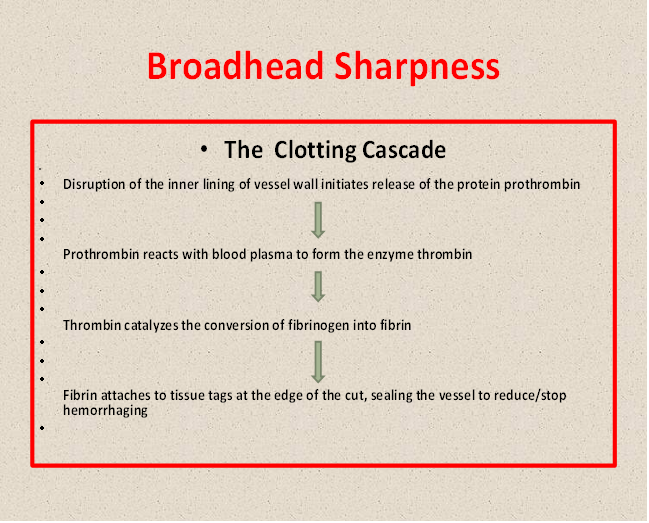Forum Replies Created
-
AuthorPosts
-
in reply to: Arrow Integrity #50009
I did do a lot of ‘extreme punishment’ integrity testing of the IF’s (direct and oblique impacts) with shots against a piece of armor plate (the hatch cover from a personnel carrier) when I was trying to find the best IF setup but that’s still not the same as shooting heavy bone, where there are multiples of more complex curved surfaces ‘bouncing things around’. Best final testing is still fresh, in situ heavy bone.
Ed
in reply to: Arrow Integrity #49417Doc Nock wrote: Perhaps, ED, there are those here who would “volunteer” to do further impact and indirect impact testing under your watchful eye and control…:?:
I’ve been encouraging a few folks along those lines. Hardest part is gaining access to enough test animals.
Ed
in reply to: Getting started, need help #48070Here’s a link to Troy’s EFOC/Ultra-EFOC tuning article.
http://www.tuffhead.com/education/tuning%20the%20efoc%20shaft.html
I have not used it but am told Stu’s calculator is not extremely accurate when dealing with EFOC and Ultra-EFOC arrows.
Wouldn’t be surprised if Troy doesn’t show up soon to give you some input too … unless he’s out hunting!
Ed
in reply to: Arrow Integrity #46675Points 1 and 3 are correct. On point 2 it’s important to understand that there are two aspect to increasing integrity; direct impact and angular impact. Any footing increases integrity to direct impact, at least to some degree. The tough one was angular impacts. That’s where the gradually tapering back portion of the IF worked better than any parallel footing.
To the best of my knowledge no one manufactures a suitable IF. Several have tried with synthetic materials, but to no success. However, O.L. reported good success with a series of carbon tubes/rods as an IF. He used one tube that fit the shaft’s inside diameter, a second tube that fit inside that one and, finally, a carbon rod inside the second tube. The second tube was longer than the first and the rod longer than the second tube, creating a ‘step down’ taper. This IF was heavier than the hardwood IF’s I used but was easier to get precise weights with.
The Grizzly Stick was the toughest carbon shaft I tested.
I know of no one that has done further testing with the ultra-EFOC setups to determine the durability. I was only able to test the direct impact, and even that was very limited testing but with significant enough results to strongly suggest that the Ultra-EFOC setup was more durable to direct impact. Further testing was planed for the next round, but my back injury, and subsequent surgeries, has pretty much halted that plan.
Ed
in reply to: Arrow Integrity #45953Here’s a thread that will help some:
https://www.tradbow.com/members/cfmbb/messages.cfm?threadid=736A1B20-1422-1DE9-ED06A7419D523D48
The Update information on Internal Footings starts in the 2007 Updates, Part 2 or 3, I think.
Hope that helps,
Ed
in reply to: CO wildlife department promotes Ashby research! #36838Doc Nock wrote: Adrian,
I’m at best a ‘turn-key’ computer operator so that wouldn’t be for me…
Doc, Adrian’s program is pretty much ‘turn key’. It’s easy to use and I’m finding it to be a great tool. Besides showing how small the effect on arrow trajectory is as arrow weight increases another neat thing is that it will let you see the drag effect of large fletch9ing, compared to smaller fletching. Worth having.
Ed
in reply to: Water and the A&A fletch #31475Forager wrote: Can someone provide a link to the discussions or info on the A&A fletch, please?
Thank you.
Here’s a link that will give you a start. The basics of the A&A fletch is maximum height if 1/2 inch (regardless of length), a straight 90 degree cut at the back and a straight taper to the front. It is used with a Turbulator placed 1/4 inch forward of the feather’s leading edge.
https://www.tradbow.com/members/cfmbb/messages.cfm?threadid=C8EA4FBD-1422-1DE9-ED1A1C909376B7B6
Ed
in reply to: 300 Tuffhead testimony #22298David Petersen wrote: … that exit wound looks like a hand grenade went off in it!
… ans the last paragraph on the clotting cascade article explains why.
Broadhead Sharpness and the Clotting Cascade
The clotting cascade is the physiologic process the body uses to seal off a bleeding blood vessel. When a blood vessel is cut the damaged cells lining the inner wall of the blood vessel release a protein called prothrombin. Prothrombin reacts with the blood plasma to form thrombin. Thrombin acts as a catalyst to convert fibrinogen into fibrin. The fibrin attaches to the ragged tissue tags at the cut edge of the blood vessel to form a clot, sealing off the vessel.
What’s important to recognize is that the type of edge finish on your broadhead has an effect on the clotting cascade. When you use the thinnest, smoothest, sharpest edge finish fewer of the cells lining the blood vessel’s inner wall are damaged. This means less porthrombin is released. At the other end of the cascade this means less fibrin is produced; but there’s more. That thinnest, smoothest, sharpest edge also results in fewer tissue tags at the cut end of the blood vessel. That means there are now fewer tissue tags for the reduced amount of fibrin to attach to. The net result is a cut that bleeds both more freely and for a longer period of time, and that’s exactly what we want.
It is noteworthy that single-bevel broadheads have a thinner edge than double-bevel broadheads. A single-bevel broadhead sharpened at a 25 degree angle, the standard sharpening angle on virtually every single-bevel broadhead available, has a total edge angle of 25 degrees. Most all double-bevel broadhead are sharpened at a 25 degree angle on each side of the edge, resulting in a total edge angle of 50 degrees.
At equal levels of edge smoothness and sharpness the significantly thinner edge of the single-bevel broadhead results in less damage to the cells lining the walls of the blood vessels and fewer tissue tags, resulting in freer and longer lasting hemorrhaging from each vessel severed. When compared to a double-bevel broadhead of matching profile and edge finish there is a consistently observable increase in the level of bleeding into the soft tissues from a single-bevel broadhead wound.
in reply to: 300 Tuffhead testimony #19884I, too, think shots from ground level are more effective than shots from elevated positions. I have always felt that, though blood flowing from a low entry or exit wound leaves a good blood trail, bleeding that is retained within the thorax helps promote lung collapse.
That notwithstanding, there are so many possible influencing factors that could result in a time difference to collapse. One is the degree of flight response elicited. When heavier bone is hit there is a heavier ‘felt impact’, which usually results in an elevated flight response and longer time to collapse. The heavy bone hit is also a relative thing. An arrow impacting a heavy bone on a 125 pound doe is, relatively, a much heavier ‘felt impact’ than is the same arrow hitting a heavy bone on an elk. A good example of this is that most animals showing no reaction, beyond a minor ‘flinch’. to a pass-through hit generally occurs only on shots that hit very little bone. (This is also an advantage of the higher Mechanical Advantage broadheads; they transfer less force to a bone in order to breach the bone, resulting in a lower ‘felt impact’.)
Of course things like level of broadhead sharpness is a factor, as is the specifics of the organs and vessels hit, and the severity of the wound inflicted to each. The physiologic and psychological state of the animal immediately prior to the time of the hit is, no doubt, also a large factor in collapse time.
Ed
in reply to: Water and the A&A fletch #19851Good info to know. I’ve always used Trueflight feathers, with great success, so never noticed this difference.
As far as I know no one is marketing an A&A cut feather. Everyone just cuts their own.
Ed
in reply to: 300 Tuffhead testimony #18937Sounds like that second doe was a one-lung hit. I’ve seen several animals survive one lung hits for a very long time, and some even recover fully. My brother shot a oryx in Namibia (with a rifle) that had a .58 caliber mini-ball (apparently from a muzzle-loader) in one lung. The slug had been there for a long, long time. The lung was collapsed and the slug was totally walled off by tissue but the oryx was getting along just fine.
Even after I’ve waited a long time before following up I make it a point to always stalk every downed animal. When I first locate them I carefully check them out through the binoculars to see if I can detect any sign of life. It sometimes provides a chance for a second, finishing shot, if needed.
Unfortunately, unless the animal is recover it’s impossible to know for sure what happened.
Ed
in reply to: A chuckle with Chuck #17098It’s a deal!
Ed
in reply to: A chuckle with Chuck #14891Mike – that’s before the day’s first “sundowner”!
Ed
in reply to: A chuckle with Chuck #13746in reply to: Bow Poundage for Pheasant Hunting #54096“Back when”, I had the best results when using sharp broadheads. The head I used most on birds was the Herter’s Ram MX; a rigid 4-blade.
Speed of the six-fletch flu-flu arrows can be regulated by the size of the fletching. I used six, shield-cut 4″ feathers; pretty fast.
Ed
-
AuthorPosts



